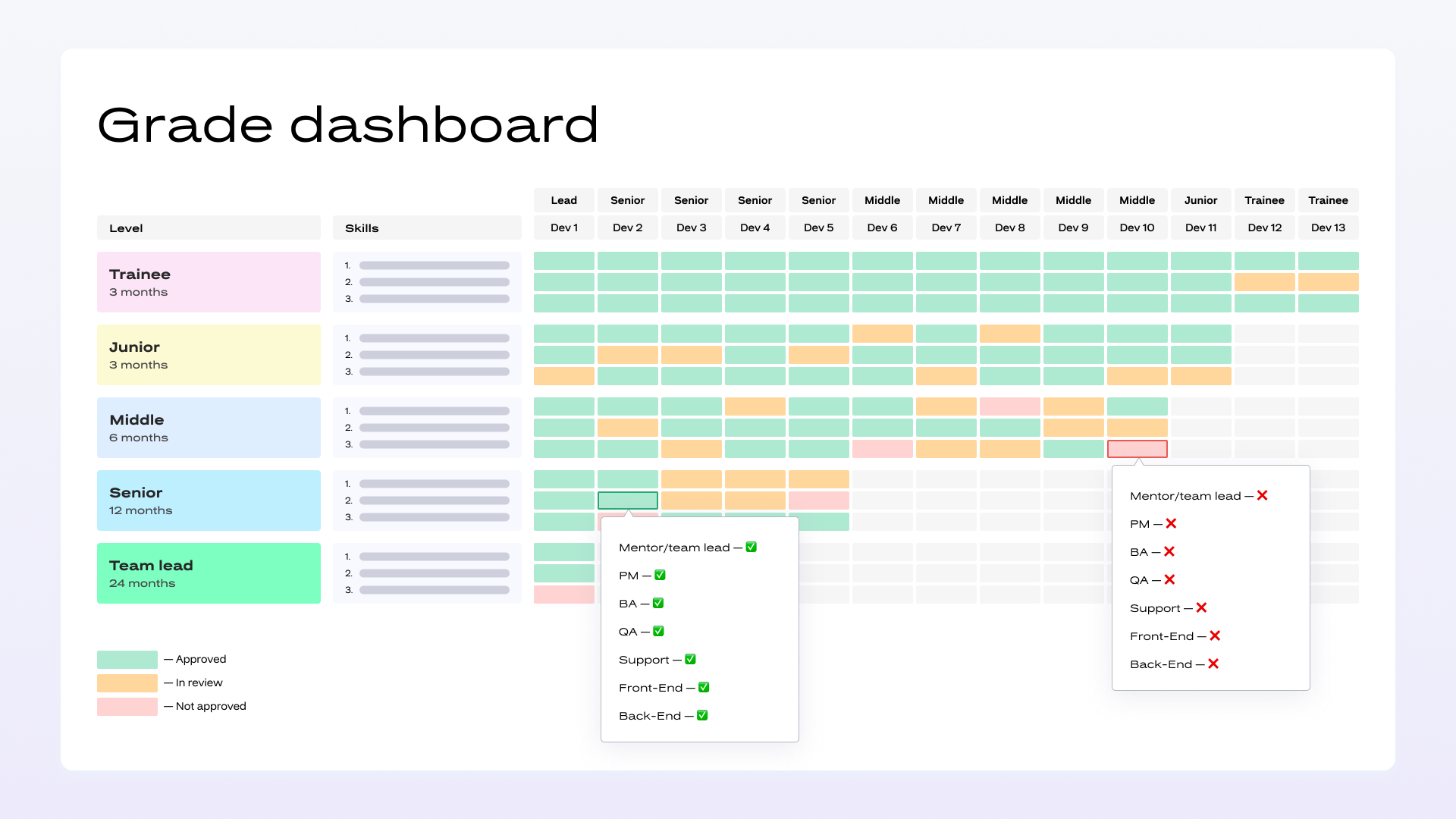Hello! My name is Taya Valko, and I am the Team Lead of low-code developers at the IT company Kitsoft. Our company has developed a low-code platform, which is currently powering dozens of simultaneous online services for various government portals, including the Diia portal.
For such scalability, we needed a managed approach to training and growing low-code developers, as these specialists are scarce in the market. In this article, I share how we accomplished this and how we addressed the challenges. This article was initially published on DOU.

Taya Valko, Team Lead of low-code developers at Kitsoft.
Who are low-code developers?
Low-code developers are professionals who work with low-code platforms, such as Liquio, to create online services without the direct involvement of traditional developers. In your company's case, Liquio is a low-code platform based on BPMN technology, enabling the development of online services without the need for extensive coding efforts (developers focus on refining the platform itself).
Within the low-code platform, several teams, known as streams, collaborate to create online services. These teams typically consist of business analysts, low-code developers, testers, and project managers. The process begins with business analysts analyzing paper processes, transforming and describing them, considering the technological capabilities of the platform, external systems for integration, regulatory documentation, and accessibility standards.
Following this analysis, low-code developers configure the business process on the low-code platform. They handle tasks ranging from creating service requests, processing user submissions, to notifying users of the results.
Working within the system requires specific knowledge and skills. However, in the Ukrainian market, there is a scarcity of specialists with the required expertise in BPMN process modeling. Additionally, teams from other IT companies and government enterprises work on the platform your company has developed.
As the number of government services to be launched increased, your company had to rapidly scale and needed a substantial number of low-code developers. To address this, your company implemented a three-stage approach:
- Recruitment of specialists: Seeking professionals with a minimum of one year of experience in web development and knowledge of Javascript, JSON, HTML, CSS, XML.
- Training on the platform: Providing education on working with the platform, including forming BPMN diagrams and filling in the functional content of each element.
- Active development with a grading system: Actively promoting further growth through a grading system that allows individuals to progress from Trainee to Senior within one year.
What is the grading system
Grading is a system of evaluating and ranking positions, whereby positions are classified into levels (grades) based on their value to the company.
On one hand, grading has allowed us to increase employee motivation by providing them with a transparent tool to influence their career development from the beginning. On the other hand, it ensures controlled quality for the company's service creation and addresses a range of recurring problems.
Here are specific goals we aimed to achieve through the implementation of grading for low-code developers:
-
Build a clear and transparent motivational system. Before implementing grading, we lacked a complete understanding of what constitutes employee growth and when they are eligible for a salary increase. Initially, we focused on work experience and the number of completed projects. However, the pace of development for specialists who started together could differ, and salary increases occurred simultaneously. The question of an employee's personal development pace with clear goals for both the company and the individual arose. Grading eliminated questions like "When can I request a salary review?" and "How much can I expect?"
-
Eliminate uneven functional proficiency. Different teams work on services for different clients, and it happened that some used one functionality while others used another. For example, some excelled in integrations, while others excelled in payment implementation. When specialists changed or moved to other teams, it complicated the process and affected project deadlines.
-
Streamline mentor work. Several experienced specialists, including mentors, project managers, and team leads, participate in onboarding and training new employees. The challenge was to allocate their time for developing new specialists without hindering other tasks. The grading system helped optimize collaboration at all levels.
-
Promote the development of truly important skills for the job. Through grading, we minimize cases where a specialist lacks necessary skills for the company, and simultaneously, the company does not overpay for skills not used in that position.
-
Minimize recurring mistakes and solve problems correctly. If a failure occurs, we conduct a retrospective to find a solution. Sometimes, to ensure implementation, we add it to the grading for a specific position. For example, after accidentally erasing part of the code without informing anyone, leading to errors in the system, we defined solutions and added them to the grading to avoid critical situations and ensure proper error handling.
-
Improve the atmosphere of psychological safety in the company. Uncertainty is a strong stress factor leading to burnout. Transparency and the ability to influence are factors in mental well-being.
The grading system is part of the team agreement, a team agreement on how we work, what is important to us, and what is necessary for progress. Employees see specific goals, feel in control of their lives, and can focus on work rather than worry about the future.
How to create a grading system
Initially, the company and management must clearly understand why they need a grading system and whether they are truly ready to allocate resources, both financial and time to it.
The financial aspect involves the company's ability to increase salaries according to the specified goals for transitioning to the next level. Therefore, it's essential to honestly answer the question: "How much are we willing to pay for each level?"
The time factor involves the need to allocate time for management to develop the system, keep it up to date, train, and assess the defined skills. This takes a considerable amount of time.
If the finances are approved, and someone is willing to undertake the development of the grading system, you can move on to specific steps. Here are the steps we took:
Step 1: Define strategic goals—what are we aiming to achieve? This should align with the specific needs of your company and specialization.
Step 2: Define the grading structure. For example, for us, these were standard positions: Trainee, Junior, Middle, Senior, and Team Lead.
Step 3: Define evaluation criteria—how should levels qualitatively and quantitatively differ? To avoid discrepancies in whether tasks at each level are truly completed, it's helpful to describe evaluation indicators and provide examples. These could include task links, projects, discussion chats, documents, and other artifacts.
Acquisition of skills or task completion is marked with a status. These could be statuses like Doing, Done, Reject; Confirm, Clarify, Disapprove; Introduced, Completed Once, Constantly Performing.

An example of a pivot table for managing team grades
Step 4: Define roles—who will conduct the grading, provide confirmation of progress, and assess task completion, etc.
Step 5: Ensure the real opportunity for an employee to achieve all set goals at each level. For this, conditions must be created, tasks of the required level in the workflow, a knowledge base, etc., should be available. After the theoretical development of the system, it needs to be brought to life—implemented.
Step 6: Distribute existing employees according to the new system. Determine the employee's current position.
Step 7: Prepare a presentation to demonstrate the new system within the company. Any changes may be perceived with concerns, so it's important to address all questions. Providing consultations, creating instructions, etc., can be good practices.
Step 8: Test and provide feedback. The grading system requires regular updates according to the company's strategic goals, the actual situation, and changes that may occur.
Factors for grading
When creating a grading system, it is essential to adhere to its ideology, where the primary motivation for the employee is growth and the corresponding salary increase. The level of payment for each position can be determined by various factors, and we have identified several key ones for ourselves:
-
Level of atypical tasks processed by the employee:
- Employees handling tasks beyond the standard scope may be considered for a higher grade.
-
Work volume within a specified timeframe:
- The ability to efficiently manage and complete tasks within set deadlines can be a determining factor.
-
Delegated responsibility:
- Assessing the level of responsibility that can be entrusted to an employee is crucial. As employees move up the grades, their capacity for handling greater responsibilities should increase.
-
Initiative and growth pace:
- The employee's proactiveness and the speed at which they demonstrate growth can influence their grade.
-
Teaching others:
- The ability to effectively transfer knowledge to colleagues is valued. While it may not be a significant factor at lower levels, it becomes increasingly important as one progresses.
-
Soft skills and effective communication:
- Communication skills evolve with each grade. For example, at the Trainee level, teamwork is crucial, while at the Junior level, inter-team collaboration (with support teams) becomes important. Middle-level specialists engage with clients and discuss refinements, and at higher levels, representative communication such as interviews and training partners comes into play.
-
Security:
- Considering security as a lifestyle, the responsibility for cybersecurity increases with the position. Higher-level positions entail a greater responsibility for ensuring cybersecurity.
Each of these factors contributes to the overall assessment of an employee's performance and growth potential, aligning with the company's goals and the specific demands of each role. Regular reviews and adjustments ensure that the grading system remains relevant and effective over time.
Failures during implementation
Although the grading system has already demonstrated quite high effectiveness, various cases arise during the implementation process.
The first issue is the lack of clearly defined goals and the method of their achievement. Sometimes a grading point may have a rather abstract requirement, which is understood differently by each person. Therefore, we have maximally detailed such points, adding examples or performance criteria.
Imposing rigid time constraints on goal achievement was not a very successful decision. This increases the level of stress and overload for specialists, especially when there is a rule to prioritize real tasks over developmental ones. To address this, we introduced more flexibility.
We also noticed a relatively high level of dissatisfaction with grading among those who have been working for a long time, while newcomers did not experience such a problem. Therefore, it is important to create conditions where there will be transparent feedback from individuals undergoing grading.
In general, established feedback mechanisms will help identify any problems in a timely manner. Then, the implementation of the system will be perceived by the team not only as an evaluation but also as collaborative work and collective development.
What the team says
To understand how grading influences motivation and work efficiency, we asked the employees themselves and noted a few responses:
"With grading, I encountered it for the first time. For me, it's like a roadmap: every step is outlined with clear deadlines. All employees in the company have access to the grading system, and the procedure is the same for all low-code developers. However, there was a downside to this standardization. We work on different projects and with different clients. It happened that someone had a real task on their project where they could implement functionality X, necessary for grading, while someone else's project did not require this functionality at all. But we noticed this and found a solution to create synthetic tasks that allow acquiring the required grading skill and preparing to use it in real projects."
Victoria Doroshenko
 Low-code team.
Low-code team.
"At other workplaces, I haven't encountered grading. Everything just went on its own, but it was unclear. You're working, and at some point, you realize that you don't know what to expect next. Here, on the one hand, we have to complete a whole list of tasks to move to a new level; on the other hand, it helps to work faster, easier, and more qualitatively. Moreover, the plan includes regular meetings and discussions with the Team Lead to receive constructive feedback."
Anastasiia Shchastna
"For me, grading has both pros and cons. The system shows a transparent path and creates clear career management expectations. But sometimes, you might get stuck at some stage. This can happen due to other participants in the process, overall work rhythm, or the opportunity to complete a task. However, it is clear what needs to be done to move forward. My wish: make the points that do not depend on the employee in such a way that they do not block the transition between levels."
Andrii Savon
"I like grading for its transparency. A clear list of points focuses on the important aspects to move more efficiently to a new grade. The most important, in my opinion, is the opportunity to master skills that will be needed in the future, sometimes even through synthetic tasks."
David Glazkov
What's next?
Moving forward, grading has allowed us to better understand the low-code developer profession, positively impacting the recruitment process and the overall satisfaction of our team.
Grading has also become a powerful argument for attracting new, talented employees. During interviews, candidates can already see opportunities for development within the company.
It is crucial to keep the grading system open. This fosters healthy competition, enhances motivation to quickly and effectively complete all tasks, and creates a transparent environment. All employees can see that the company is willing to invest time in their growth and values development.
We continue to refine the grading system for low-code developers; it is an ongoing process. Currently, we are launching the development of grading for the testing team, and we are excited to share our experience.
I wish all of you who dare to implement grading courage, as it is not an easy process, and there is no well-trodden path. Your experience will be unique, special, and therefore valuable.